How to write a meeting agenda (and run better meetings!)

Learning how to write a meeting agenda that sets the stage for an effective and engaging gathering is an important leadership skill. Not only will it help you be organized and on time, but it will also help you and your team make the most of your time together.
In this guide, we’ll explore what makes a meeting productive and guide you through the process of designing a great meeting agenda. You'll also learn practical tips you can use to improve your next meeting and get every team member engaged and involved. Ready to leave behind boring, unproductive meetings? Let's dive in!
Going into a meeting without a purpose or a clear sense of what you’re going to cover rarely results in a productive session. Writing a clear step-by-step meeting agenda is a great way to improve your management and facilitation practice. Not only will you be more effective as a team, but you can avoid frustrating or unproductive meetings and get better results too!
In this guide, we’ll explore what makes a productive meeting and guide you through the process of designing a great agenda. Additionally, we’ll also share some sample meeting agendas so you can see some working examples you can use as the basis of your next meeting.
What is an agenda?
In short, an agenda is a breakdown of all the items that will be covered during a meeting. It should list all of the topics and tasks that will be covered during the meeting and also clearly articulate the purpose and expectations of the meeting.
Your meeting agenda should also give everyone involved the information they need to successfully attend and adequately prepare. This means including all information relating to logistics, links and attachments and mentioning any preparations you wish everyone to do before the meeting.
The best meeting agendas also help you effectively run the meeting on the day by giving you a step-by-step list of what to cover and timings for each major section of the meeting.
A meeting agenda is usually created in a clear, shareable format, such as a Word document or SessionLab agenda. This makes it easy to follow and share with meeting participants.
You can see some examples of a meeting agenda template here. These meeting agendas include meeting objectives and a step by step process complete with timings so you can see how to put them together effectively.
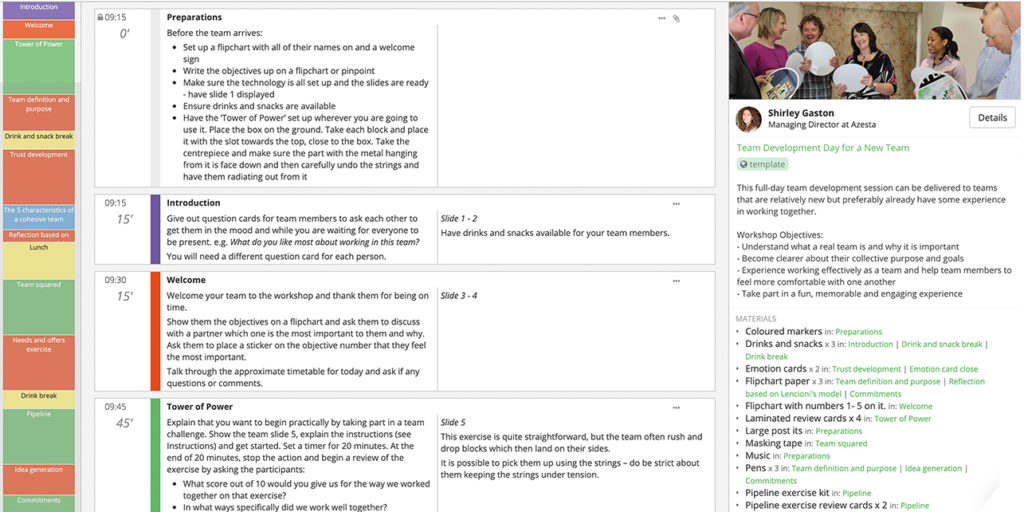
Why is a meeting agenda important?
A meeting agenda is an effective tool for many reasons. First up, it helps ensure the meeting facilitator has everything they need to run an effective meeting. You’ll have an itemized list of every agenda item, reminders of the meeting goal and all your relevant documents attached too.
Perhaps most importantly, a meeting agenda is how you can your meeting participants can stay on track and ensure everything that needs to get done is completed.
Without it, your team meeting can quickly go off the rails or be unproductive. It helps other team members be aware of your core meeting objective, what’s going to be covered, and to give them time and space to prepare.
Preparation
By outlining what will be covered in your meeting, your agenda will ensure every team member can adequately prepare. This might mean preparing discussion topics, supplementary materials, or other items.
Creating your meeting agenda and sending it out well in advance means everyone can do what they need to come to the meeting and make it a success. If you want your meeting attendees to contribute meaningfully, give them a chance to prepare with a good meeting agenda.
Scheduling and logistics
In the most basic terms, a meeting agenda will help everyone involved align their schedules and attend. By including the location or virtual room, date and time, and any necessary links, your meeting agenda will contain all the information people need to be there and adjust their calendars.
You’ll also include information on how long the meeting will run for and timebox each section. If you have multiple people leading sections of the meeting, ensure you include clear timings for each of those sections so everyone can prepare and keep the meeting on track.
Productivity
Even the most simple meeting agenda will enable both the facilitator and participants to be productive. Going into a meeting with a clear agenda and timeboxed schedule means you and your group can be more effective and not get lost in side-discussions or unagreed topics.
In short, an effective meeting agenda clearly sets the stage for what will and what will not be included and can ensure everyone is pushing in the same direction during the meeting.
Get team buy-in
Going into a meeting without clear expectations or an idea of the talking points is frustrating for everyone involved. Make meetings work for everyone by creating and sharing the agenda with the participants and agreeing on the format.
Getting everyone on board can massively increase the productivity of any project or meeting and by developing a standardised agenda that makes it easy for everyone to understand and attend, they’ll fit more naturally into your team workflow too!
Improve your planning
Documenting your meeting agenda is the first stage in improving the quality of your meetings. DId you find that something in your agenda plan didn’t work out? Need less time for old business and more time on new items or setting follow-up actions? Go back to your agenda and adjust. Use a collaborative agenda planner tool if you want to get comments and feedback on your meeting agenda!
Simplify a recurring meeting
In the case of recurring meetings – whether it be board meetings or a weekly meeting to catch-up – creating an agenda can simplify and streamline the process.
In SessionLab, for example, you can create a meeting agenda template or simply duplicate your session so you don’t have to start from scratch every time.
Improve meeting culture
Creating a meeting template that works for everyone and has been refined over time can help make your entire team more productive and shift the mindset around meetings.
The work you do in meetings can and should improve all the work you do and a better meeting culture can help teams communicate better and surface issues effectively in any context.
Help identify and remove ineffective meetings
A common complaint of most teams is that they have too many meetings or that the meetings they have are ineffective.
Agenda-setting and following a process when developing your meetings can also help you and your team identify if a meeting should be run at all. We’ll cover this in more detail in our final section on how to decide if you should run a meeting too!

What to include in a meeting invite?
Getting people to attend the meeting means sending a meeting invitation that includes all the necessary information in a simple, easy to understand format.
You’ll likely send your meeting invite as an email or Calendar invite, though you might also use other dedicated meeting software. Here’s what you should include for your next meeting.
Meeting logistics
Here, you’ll include everything your participants need to know in order to attend the meeting. Including:
- Title of the meeting
- The date and time of the meeting
- The location of the meeting
- For virtual meetings, include a link to the virtual meeting room and any necessary passwords
- The run-time of the meeting
- Host (and co-hosts) of the meeting
- Additional meeting roles such as note taker
- List of participants
Purpose of the meeting
Ensure you include the purpose of the meeting in your agenda so everyone can understand why they’re being asked to attend and prepare adequately. You may also want to include any links to resources or co-creation documents. Additionally, include any background information to help participants understand the context of the meeting. If it’s the first in a series of meetings or a project retrospective, be sure to include that information here.
Preparatory work
If you have any preparations you wish participants to make before the meeting, include them here. This might include contributing ideas to an online whiteboard, reading a document that will be discussed, or preparing questions around the central topic of the meeting. Be sure to include links to any resources and make instructions completely clear.
Meeting agenda
The final section of your meeting invitation should be the agenda for your meeting. This should include a clear, simple list of the topics you will be covering. If a discussion item is led by someone other than the primary facilitator, include that information alongside each entry too. Ensure that the meeting agenda you send your participants covers everything
What to include in a meeting agenda
Meetings of different purposes and may require different items in their agenda, though they should broadly follow the same structure in order to ensure the whole team can move through it productively.
Remember to set timings for each section so your meeting can run on time and give everyone an indication of the scope of the discussion.
It’s worth noting that while you might have a detailed meeting agenda for yourself and any co-facilitators, you might share a simplified version with your participants.
So long as you ensure that everyone attending has the information they need and a sense of each agenda item, your agenda can be as detailed or as simple as necessary. Let’s dive in!
Introductions and housekeeping
Here, you’ll make sure everyone who needs to be in the meeting is present and make introductions where necessary. You’ll also briefly reiterate the purpose of the meeting and introduce the meeting leader too.
In a virtual meeting, allow extra time to solve technical issues and get everyone on camera.
Icebreaker (optional)
Meeting icebreakers can be a great way of helping new groups get to know each other or warm-up and prepare a team for a difficult conversation ahead. Depending on your meeting format, agenda and length, you may want to include an icebreaker at the beginning.
Remember that not every meeting needs an icebreaker. A regular weekly standup doesn’t need an icebreaker to warm everyone up. A board meeting with a tight agenda may not need this step either.
On the other hand, an interdepartmental meeting where people are coming together for the first time to discuss better ways of working might benefit from an icebreaker.
Meeting topics and items for discussion
This is the main bulk of the agenda. Here, you’ll set out all of the items to be covered in your meeting. These might include a review of what was accomplished in a previous meeting, presentations of news and information, discussions, collaborative exercises and more. These items are completely contextual depending on the nature of your meeting and in our next section, you’ll see some example meeting agendas that include all kinds of items.
Be sure to set a time for each item in your agenda and include a short description. If someone other than the host is leading this section, include that information too. Remember that the purpose of the agenda is to not only outline these items so people can understand the meeting at a glance but also give them opportunity to prepare.
Breaks (optional)
In longer meetings, breaks can be vital in ensuring everyone stays engaged, energized and is able to contribute meaningfully. As a general rule of thumb, a break every 1.5 to 2 hours is a great way to keep everyone happy and keep up group energy levels. Remember that virtual meetings are often more draining and so the necessity for a quick break is even greater in those situations.
Set follow-up actions
Whatever the format or purpose of your meeting, there are likely to be follow-up actions that should be agreed upon before you adjourn. These might include taking action on items discussed during the meeting, sending notes or resources, or simply agreeing the time and date of follow-ups or later meetings. The more complex the meeting, the more involved this part of the agenda is likely to be, so ensure you set adequate time for this.
When setting follow-up tasks, be sure to give each task an owner and agree with your team members when they will be completed or checked in on. Ownership and timeboxing can help ensure that items set are completed in a timely manner.
Closing
All meetings should be brought to an effective close. Give participants an opportunity to add any final items, give feedback or briefly clarify any hanging questions before closing the meeting can help ensure follow up actions are taken and that everyone is on the same page leaving the meeting.
You might even use a closing activity from our library of facilitation methods to help your group meaningfully reflect on the meeting.
Tips for writing an effective meeting agenda
Once you know you are running the meeting and have an idea of the framework of the agenda, you’ll want to write up your agenda so you can share it with your participants. This means getting every agenda item in order, articulating your meeting objective and designing for flow and engagement.
Creating a great meeting agenda doesn’t need to be a chore. Check out our tips below for help in writing a meeting agenda that can help your meeting be a success and improve your general meeting facilitation too.
Clearly identify and articulate your meeting goal
One common frustration point for meetings is that not everyone is on the same page regarding the goal or purpose of the meeting. Be absolutely clear on what falls under the remit of the meeting and what falls outside of it. By doing this, you can ensure all attendees are aligned going into the meeting, and you can also identify if additional work needs to be done elsewhere.
If the goal of a meeting is to align your marketing and product teams on a specific project make sure everyone knows it. When running a board meeting, make it clear what you’re going to cover so that everyone’s time is respected. By identifying and sharing the goal and purpose of the meeting early, you’re helping everyone make it a success.
Ask participants for input
If you’re running a meeting that will benefit from the input of participants, ask them to contribute ideas or possible agenda items in advance of the meeting. Not only can you ensure that the meeting is fit for purpose, but you can also source the best ideas and get team buy-in too.
You might also find that some sections of the meeting are best led by certain team members or stakeholders. Be sure to liaise with those people beforehand and let them know what sections they’ll be running, when and for how long. Switching meeting leaders can be productive, but only if everyone has had a chance to prepare!
List the topics you want to address
If your meeting is following a discussion format, ensure that you include a list of all the topics or questions you will be discussing in the agenda. Though you might find these changes on the day, listing all of these items ensures participants know what to expect and can begin to prepare answers or know what to think about before the meeting.
An effective agenda should help you stay on track without effort. Having a list in place also helps with time management and prioritization during the meeting – if you know you have some key topics yet to be discussed, it helps guide the team to end one topic of discussion and move onto the next effectively.
Identify the purpose of each task
Identifying the purpose of your meeting should be the first thing you do, but when it comes to writing your meeting agenda, you’ll want to understand the purpose of each component in order to make it a success.
Group meetings always benefit from focus and so each task or item should be selected in order to fulfill the purpose of the meeting. If you’re running a project retrospective meeting, you don’t need a section on company-wide news, for example. If you were running an all-day virtual meeting, you might include an online energizer after lunch so that people come back recharged and ready to engage.
We often find that certain tasks deserve to be explored but a general team meeting is not the place to explore them. In these cases, it’s worth considering how best that work should be done – is it a separate meeting or could it be done asynchronously? Whatever the case, ensure that all of the items in your meeting agenda belong there, and that you’re not overstuffing or trying to combine two meetings.
Remember that each part of the meeting should relate to your central meeting objective. Design with this in mind and your meetings will be leaner and more productive as a result!
Timebox
Meetings that are effectively timeboxed are more productive and less frustrating for all involved. Try not to overrun and set times for each and every section of your meeting agenda. This can help prevent meandering conversations and keep everyone focused. Furthermore, people are less likely to dread attending your meetings if they run on time and they can schedule around them without worry!
Setting times for discussion items can be difficult if you’ve never run the meeting before – estimate and use your best judgement but also take notes on how much time each section took up. You can go back to your agenda afterwards and improve for the next meeting.
Be simple and clear
Meetings do not need to be complicated and neither should there agendas. Keep your meeting agenda simple, clear and short for the best results. You want your participants to get a sense of the meeting easily, understand what they need to do to prepare and attend. Remember that people tend to have more meetings than they would like – don’t make it difficult for your team members to attend yours!
Create a reusable template
Creating a meeting agenda from scratch each time is not only a waste of time, but it means you lose the potential to iterate and improve. By creating a template for your meeting agenda, you can speed up the process, develop a standard meeting schedule and also figure out where you can make improvements.
Find that your team meeting agenda overran? Go back to the template and change the timings. Find that energy levels dip in your longer meetings? Find space to include an energizer.
Making your agenda into a reusable and editable template is the first step to iterating and improving and is made easy in SessionLab too!
Keep it focused
A common mistake when designing a meeting agenda is to try and cram too much in. Your group will be much less effective if you attempt to cover lots of ground and don’t spend enough time where you need to. Try to think of the most important items for every business meeting and ensure your agenda is designed so you can focus on those things.
It is much better to cover key points with the relevant depth so you find solutions and make meaningful decisions rather than try and cover everything.
Remember that focus is contextual. A daily-standup will have a different focus to a general team meeting agenda or project retrospective. Think of the purpose or goal of the meeting – if what you’re exploring is unrelated to the goal or purpose of the meeting, it shouldn’t be in the meeting. If your goal is to align on the next steps of a project or sum up progress so far, you might cover a lot of ground but it should be related to the core goal.
Get feedback
Improving your meetings can’t happen in a vacuum. Get feedback from your participants on how the meeting went in order to improve the quality and structure of them. You can achieve this by using a debriefing activity or a round of feedback at the end of the meeting.
While this is often the most effective way of getting quick, honest feedback on your meeting, you can also send out a survey afterwards. Whatever method you choose, listen to your meeting participants and make changes so that your meetings continue to be effective and useful for everyone involved.

Meeting agenda templates
The job of meeting agenda isn’t truly complete until it’s been shared with your participants. But are you wondering what a meeting agenda template looks like and want to see how you might put the finishing touches on an agenda that you might send to clients or internal teams?
For simple meetings, an agenda that covers the main discussion topics in a simple format such as a calendar invite is likely sufficient. See our Team alignment meeting agenda for an example of a simple meeting agenda.
For more involved meetings and group processes, a more in-depth meeting agenda template should be used to adequately prepare everyone involved for the meeting ahead. We’ve included some common meeting formats that require a more complex agenda too.
These meeting agenda examples will give you a taste of what a completed agenda looks like and hopefully give you inspiration for your own. Let’s take a look!
Team Alignment Meeting
Aligning teams and discussing possible roadblocks or team dependencies is often better in real-time. Being able to bring up ideas and concerns while also clarifying any points in a structured manner can help prevent email back and forths too!
Here’s a simple meeting agenda template made using Google Calendar. Feel free to copy the format and use it for your next team meeting!
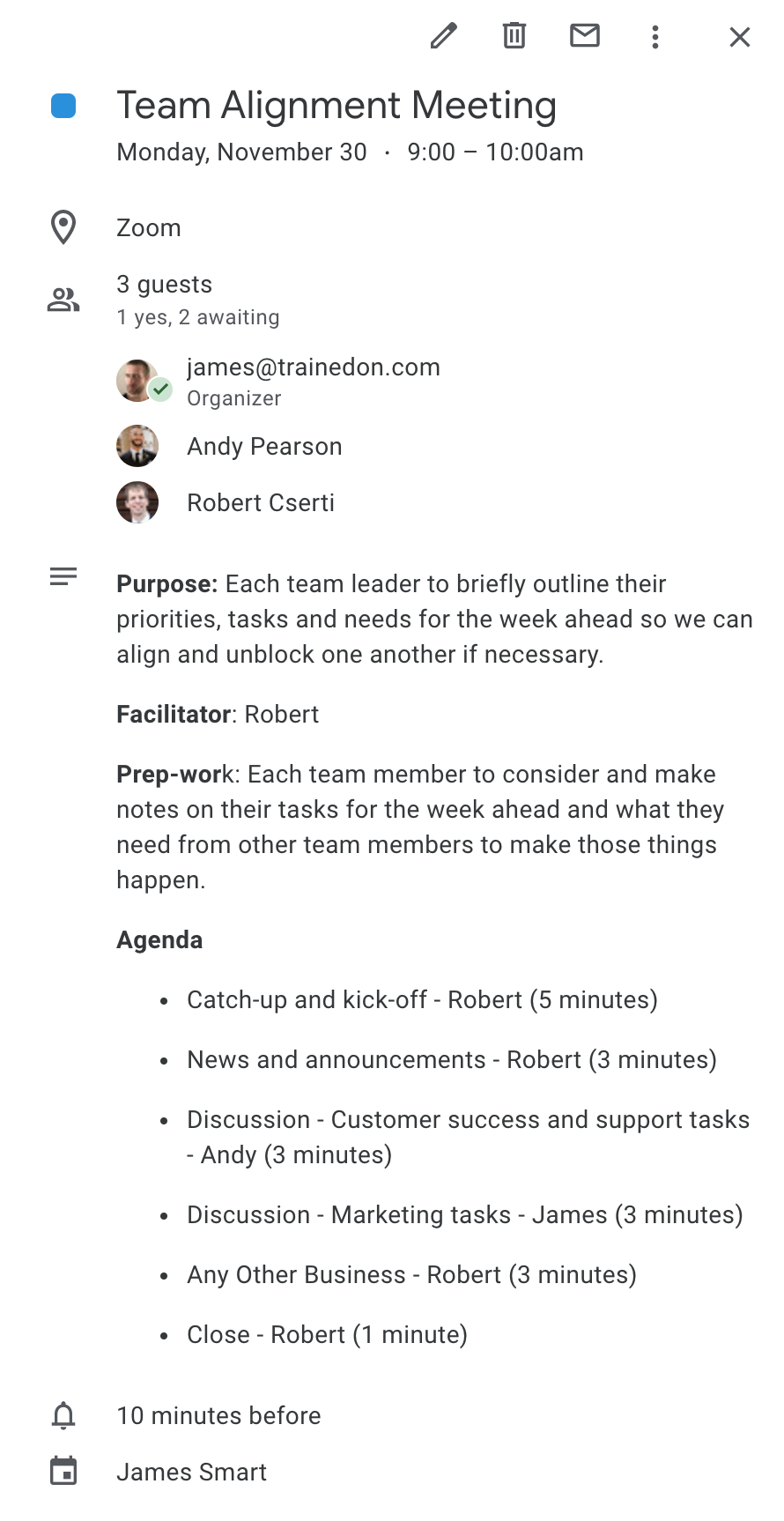
Ready for some more complex meeting agendas? We’ve chosen a few common meeting formats and outlined an example agenda for you below. Each of these meeting agendas also features a SessionLab template so you can adjust it to your own needs too. Let’s take a look!
Project Kickoff
Starting a new project is always worth getting together for. Even if you’re doing preparatory work in a collaborative Google document or working asynchronously for much of the project, a kick-off meeting in real time is an efficient way to align and surface any issues before getting down to work in earnest. Let’s take a look at this meeting agenda template to see how you can set off on the right foot with a short, one-hour meeting.
Project Retrospective
Large projects can take many twists and turns. A retrospective meeting is where you and your team will discuss and learn from such projects with a view to improve things next time around. In this retrospective meeting agenda, see how your group might effectively reflect on a completed project and bring up any essential learning points in less than an hour!
Lightning Decision Jam
Unstructured, meandering discussions can kill a team’s creativity and remove the appetite for future meetings. Use Jonathan Courtney’s Lightning Decision Jam method as the basis for a short meeting in which you can use a group process to make quick, effective and thoughtful decisions. See the method below for full instructions.
One-Hour Brain Sprint
With the right process, working collaboratively in a real-time meeting can be one of the most effective ways of generating ideas and get every team member involved. Try the One-Hour Brain Sprint template to give your next brainstorming meeting a framework for success.
How to decide if you should run a meeting?
Organized and well-facilitated meetings can be hugely productive to any group or organisation but not everything should be a meeting. In fact, some meetings can be detrimental to your team if they aren’t thoughtfully designed and run.
We’ve all felt the burnout of having too many meetings or been frustrated by a directionless meeting that feels like a waste of time. Before you set a meeting, ask yourself these questions to decide whether it is worth bringing everyone together.
Does the meeting have a clear goal or purpose?
Whenever you’re considering bringing your team together to work in real-time, it should be with a clear end result you want to achieve.
If you need to collaborate on a topic or make a decision as a group in real-time, this is a great reason to have a meeting. If you do not have a goal or purpose, you should reconsider whether you should run the meeting at all. Nothing is more frustrating for a group than a meeting with no reason to be run.
Remember that a daily catch-up or weekly progress report can be a good reason for a short meeting, though only if you can clearly articulate a goal and purpose. If you can’t, go back and clarify the purpose or goal and really determine if it’s worth holding the meeting. You might find asynchronous work or a simple email is a better option for sharing information or collaborating with your team.
Could this be summed up in an email?
You don’t need to run a meeting every time you have a small piece of information to share. If your goal is to share information quickly, effectively and without the need for discussion, perhaps that could be shared in an email or on Slack instead?
Some topics are too large for email and if you want to discuss a topic or collaborate on solutions, a meeting might still be the right approach. Before you go in this direction, ask yourself if you couldn’t transmit the information you need to share in an email and save everyone involved the time and effort of an extra meeting.
Could the meeting work be done asynchronously?
Not all discussions or activities need to be conducted in real-time. When asking a group to collect ideas or bring items for discussion to the table, ask whether you couldn’t do so in a shared document asynchronously.
Collecting insights in this way allows everyone to contribute in their own time and reflect on the topic meaningfully before adding to the discussion. You will still want to timebox the activity and potentially debrief over email or in a meeting, but allocating tasks asynchronously can not only save time but also make everyone more productive too.
Who needs to be at the meeting?
Some challenges do not need an entire organisation in order to be solved. When holding a meeting, carefully consider who needs to be in the room to make it a success. You might find that you only need to chat to one other person in Slack in order to make something happen. Alternatively, you might still hold a meeting but limit the attendees so it is useful for everyone involved.
Is the meeting an effective use of everyone’s time?
Meetings are rarely the most important part of everyone’s day. Disrupting the flow of your team’s working day should only be done if it is an effective use of time for everyone involved. Particularly in times of upheaval or heavy workload, the potential time spent in meetings can mean other work is left incomplete.
If you can achieve the same results without interrupting people whose time is better spent elsewhere, do so. Sometimes an email or invitation to a shared document is sufficient to get the work done.
Is the meeting actually a workshop?
If the scope or the complexity of the meeting grows, it might be that you are running a workshop and not a meeting. In simple terms, the difference between a meeting and a workshop is that meetings are often where things are discussed while workshops are where groups go through a process and take action.
Meetings are great for surfacing issues and discussions, while workshops are better at generating ideas, developing solutions and choosing the best followup actions. While both formats are worthwhile in different contexts, workshops employ group process, facilitation techniques and activities in order to be successful and do deeper, more involved work.
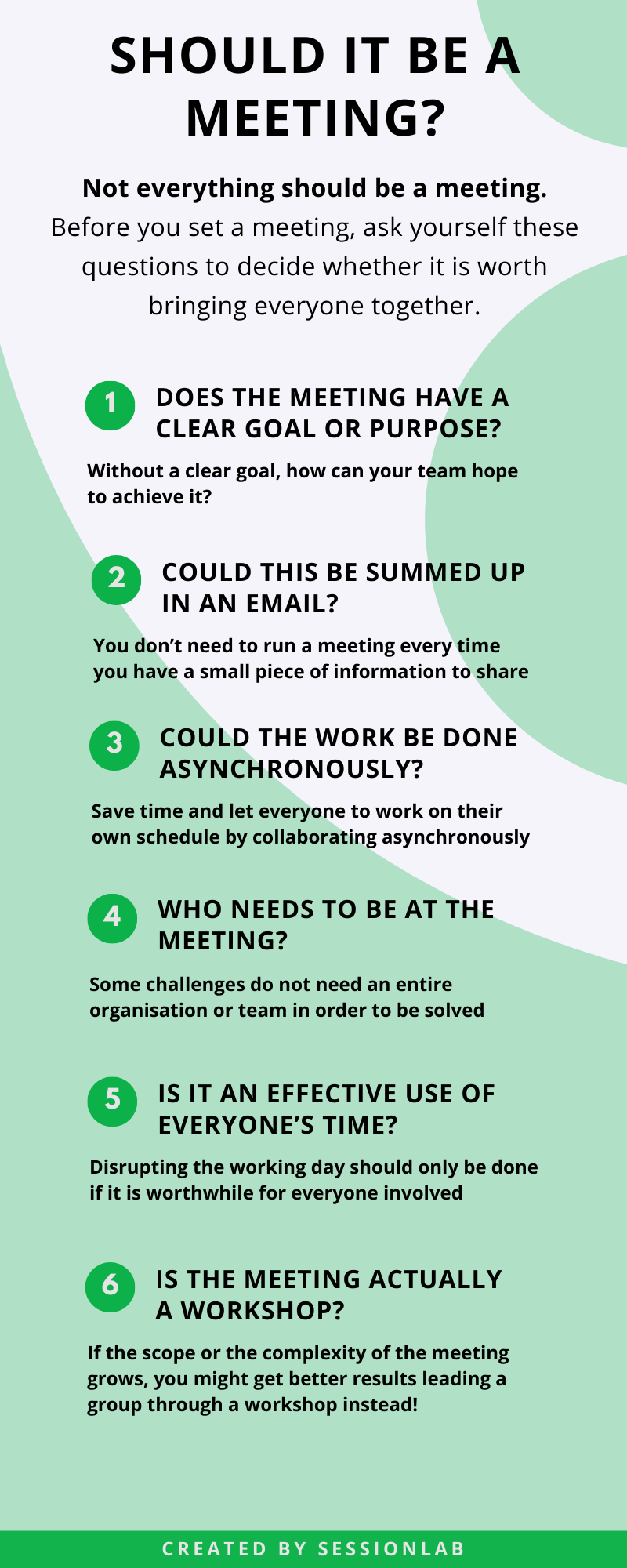
Next steps
Now you’ve written a great meeting agenda that is clear, simple and fit for purpose, you’re almost set to run your meeting! Here, we’ll explore what you should do next and point out some resources that can help you improve the effectiveness of your meetings too.
Distribute your agenda in advance
Give your participants adequate time to prepare and adjust their schedules for the meeting. Sending a complete agenda the day of the meeting isn’t sufficient and will only serve to frustrate your participants and lessen the potential productivity of the meeting.
Remember that the more complex the meeting and the greater the prep work, the more time you want to give your participants between receiving the agenda and running the meeting.
Double check the logistics
Ensure that your meeting room is booked and free if you haven’t done so already and double check that anyone assigned to lead part of the meeting is available and prepared to do so. If you’re using tech as part of your meeting, make sure you have everything you need and perform a technical test if necessary. This is especially important if running an online meeting where the success of your meeting can be entirely lost if your tech fails!
Learn how to run better team meetings
Creating an agenda for your meeting is a vital part of ensuring its success, but running the meeting and managing discussions, tasks and activities requires some additional skills. In our post on running better team meetings, find out how you can encourage better working practices and create more productive meetings too.
Improve your facilitation skills
Becoming a better facilitator can enable you to lead better meetings and make the most out of any group process. In our post on essential facilitation skills, learn all about the role of the facilitator and what you can do to be a more effective facilitator in meetings, workshops and more!
Over to you
Learning how to improve your meeting agendas can make all the difference when enabling groups to work together effectively and make the most of their time spent in meetings.
Did we miss something from the list above or did you find one of the meeting agenda templates especially useful? Let us know in the comments below?
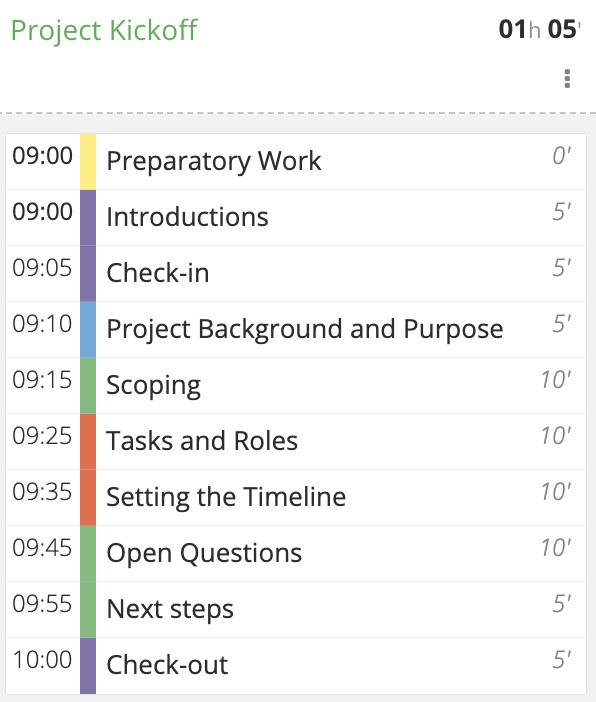
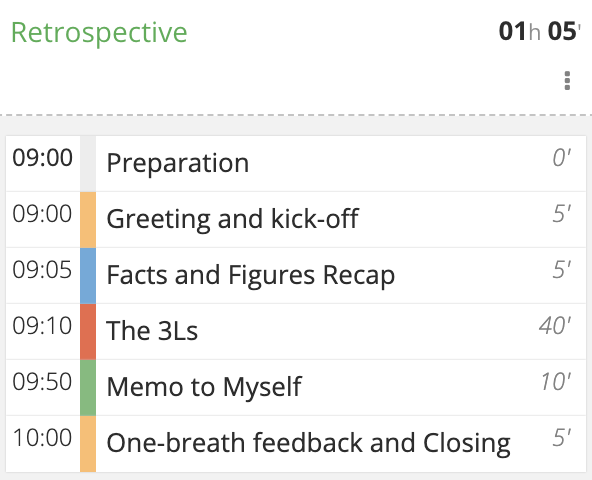
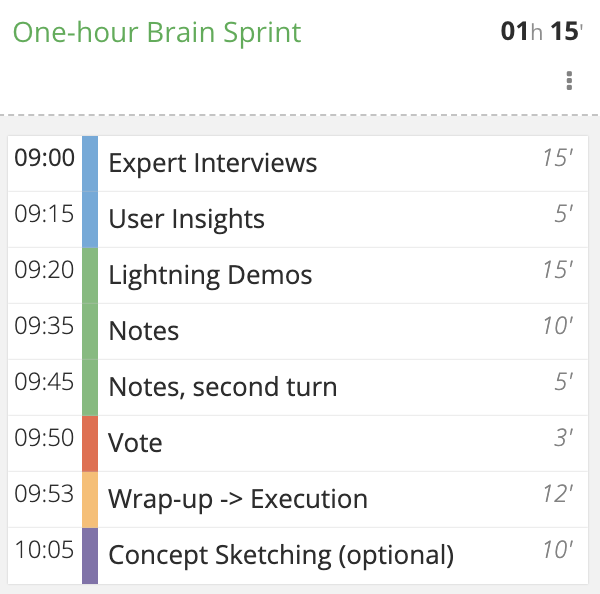
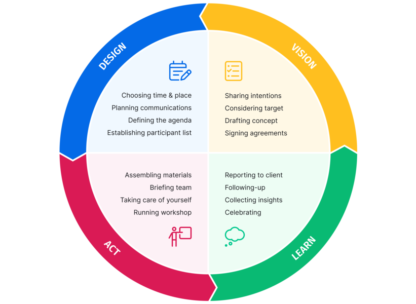
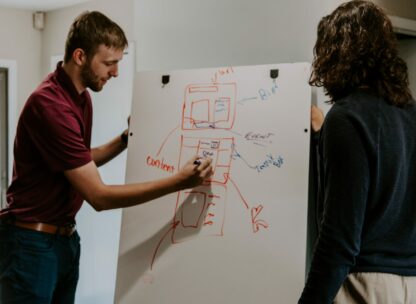

Leave a Comment